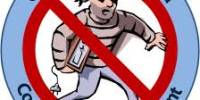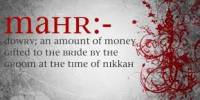Introduction:
The 2011 Egyptian revolution took place following a popular uprising that began on Tuesday, 25 January 2011 and is still continuing as of December 2011. The uprising was mainly a campaign of non-violent civil resistance, which featured a series of demonstrations, marches, acts of civil disobedience, and labour strikes. Millions of protesters from a variety of socio-economic and religious backgrounds demanded the overthrow of the regime of Egyptian President Hosni Mubarak. Despite being predominantly peaceful in nature, the revolution was not without violent clashes between security forces and protesters, with at least 846 people killed and 6,000 injured. The uprising took place in Cairo, Alexandria, and in other cities in Egypt, following the Tunisian revolution that resulted in the overthrow of the long-time Tunisian president. On 11 February, following weeks of determined popular protest and pressure, Mubarak resigned from office.
Grievances of Egyptian protesters were focused on legal and political issues including police brutality, state of emergency laws, lack of free elections and freedom of speech, uncontrollable corruption, and economic issues including high unemployment, food price inflation,[3] and low minimum wages. The primary demands from protest organizers were the end of the Hosni Mubarak regime and the end of emergency law; freedom, justice, a responsive non-military government, and a say in the management of Egypt’s resources. Strikes by labour unions added to the pressure on government officials.
During the uprising the capital city of Cairo was described as “a war zone,” and the port city of Suez was the scene of frequent violent clashes. The government imposed a curfew that protesters defied and that the police and military did not enforce. The presence of Egypt’s Central Security Forces police, loyal to Mubarak, was gradually replaced by largely restrained military troops. In the absence of police, there was looting by gangs that opposition sources said were instigated by plainclothes police officers. In response, watch groups were organised by civilians to protect neighbourhoods.
Background:
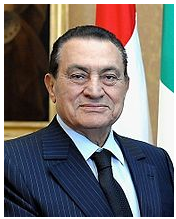
Hosni Mubarak in 2009
Hosni Mubarak became head of Egypt’s semi-presidential republic government following the 1981 assassination of President Anwar El Sadat, and continued to serve until 2011. Mubarak’s 30-year reign made him the longest serving President in Egypt’s history, with his National Democratic Party (NDS) government maintaining one-party rule under a continuous state of emergency.barak’s government earned the support of the West and a continuation of annual aid from the United States by maintaining policies of suppression towards Islamic militants and peace with Israel. Hosni Mubarak was often compared to an Egyptian pharaoh by the media and by some of his critics due to his authoritarian rule.
Inheritance of Power:

Gamal Mubarak in 2006
Gamal Mubarak, the younger of Mubarak’s two sons, begins being groomed to be his father’s successor as the next president of Egypt around the year 2000. Gamal started receiving considerable attention in the Egyptian media, as there were no other apparent heirs to the presidency.[50] Bashar al-Assad’s rise to power in Syria in June 2000, just hours after Hafez al-Assad’s death sparked a heated debate in the Egyptian press regarding the prospects for a similar scenario occurring in Cairo.
In the years after Mubarak’s 2005 reelection several political groups (most in Egypt are unofficial) on both the left and the right, announced their sharp opposition to the inheritance of power. They demanded political change and asked for a fair election with more than one candidate. In 2006, with opposition rising, The Daily News Egypt reported on an online campaign initiative called the National Initiative against Power Inheritance which demanded Gamal reduce his power. The campaign stated, “President Mubarak and his son constantly denied even the possibility of [succession]. However, in reality they did the opposite, including amending the constitution to make sure that Gamal will be the only unchallenged candidate.
Emergency law:
An emergency law (Law No. 162 of 1958) was enacted after the 1967 Six-Day War. It was suspended for 18 months in the early 1980s and has otherwise continuously been in effect since President Sadat’s 1981 assassination. Under the law, police powers are extended, constitutional rights suspended, censorship is legalised, and the government may imprison individuals indefinitely and without reason. The law sharply limits any non-governmental political activity, including street demonstrations, non-approved political organizations, and unregistered financial donations. The Mubarak government has cited the threat of terrorism in order to extend the emergency law, claiming that opposition groups like the Muslim Brotherhood could come into power in Egypt if the current government did not forgo parliamentary elections and suppress the group through actions allowed under emergency law. This has led to the imprisonment of activists without trials, illegal undocumented hidden detention facilities, and rejecting university, mosque, and newspaper staff members based on their political inclination. A parliamentary election in December 2010 was preceded by a media crackdown, arrests, candidate bans (particularly of the Muslim Brotherhood), and allegations of fraud involving the near-unanimous victory by the ruling party in parliament. Human rights organizations estimate that in 2010 between 5,000 and 10,000 people were in long-term detention without charge or trial.
Police brutality:
According to a report from U.S. Embassy in Egypt, police brutality has been common and widespread in Egypt. In the last five years, the Mubarak regime has denied the existence of torture or abuse carried out by the police. However, many claims by domestic and international groups provide evidence through cellphone videos or first-hand accounts of hundreds of cases of police abuse.
According to the 2009 Human Rights Report by the U.S. State Department, “Domestic and international human rights groups reported that the Ministry of Interior (MOI) State Security Investigative Service (SSIS), police, and other government entities continued to employ torture to extract information or force confessions. The Egyptian Organization for Human Rights documented 30 cases of torture during the year 2009. In numerous trials defendants alleged that police tortured them during questioning. During the year activists and observers circulated some amateur cellphone videos documenting the alleged abuse of citizens by security officials. For example, on 8 February, a blogger posted a video of two police officers, identified by their first names and last initials, sodomizing a bound naked man named Ahmed Abdel Fattah Ali with a bottle. On 12 August, the same blogger posted two videos of alleged police torture of a man in a Port Said police station by the head of investigations, Mohammed Abu Ghazala. There was no indication that the government investigated either case.
The deployment of plainclothes forces paid by Mubarak’s ruling party, Baltageya, has been a hallmark of the Mubarak government. The Egyptian Organisation for Human Rights has documented 567 cases of torture, including 167 deaths, by police that occurred between 1993 and 2007. Excessive force was often used by law enforcement agencies. The police forces constantly squelched democratic uprisings with brutal force and corrupt tactics.[70] On 6 June 2010 Khaled Mohamed Saeed died under disputed circumstances in the Sidi Gaber area of Alexandria. Multiple witnesses testified that Saeed was beaten to death by the police. A Facebook page called “We are all Khaled Said” helped bring nationwide attention to the case. Mohamed ElBaradei, former head of the International Atomic Energy Agency, led a rally in 2010 in Alexandria against alleged abuses by the police and visited Saeed’s family to offer condolences.
During the January — February 2011 protests, police brutality was high in response to the protests. Jack Shenker, a reporter for The Guardian, was arrested during the mass protests in Cairo on 26 January 2011. He witnessed fellow Egyptian protesters being tortured, assaulted, and taken to undisclosed locations by police officers. Shenker and other detainees were released after one of his fellow detainees’ well-known father, Ayman Nour, covertly intervened.
Corruption in government elections:
Accusations of corruption, coercion to not vote, and manipulation of the election results have occurred during many of the elections over the past 30 years. Until 2005, Mubarak was the only candidate to run for the presidency, on a yes/no vote. Mubarak has won five consecutive presidential elections with a sweeping majority. Opposition groups and international election monitoring agencies have accused the elections of being rigged. These agencies have not been allowed to monitor the elections. The only opposing presidential candidate in recent Egyptian history, Ayman Nour, was imprisoned before the 2005 elections. According to a UN survey, voter turnout is extremely low (around 25%) because of the lack of trust in the corrupt representational system.
Restrictions on free speech and press:
Even though the Egyptian constitution provides for the universal freedom of speech (Egypt Constitution, Article 47 – 49), the government has frequently sanctioned home raids, torture, arrests, and fining of bloggers and reporters that criticize the government in any way. Under the current state of emergency laws, the government can censor anything if it is considered a threat to “public safety and national security”. If any reporter or blogger violates this law by criticizing the government, they could be legally penalized with a fine of 20,000 pounds ($3,650) and up to five years in prison. The Moltaqa Forum for Development and Human Rights Dialogue reported that between January and March 2009, 57 journalists from 13 newspapers faced legal penalties for their governmental critiques. The Egyptian government owns stock in the three largest daily newspapers. The government controls the licensing and distribution of all papers in Egypt. The Egyptian government shut down the Internet to most of Egypt during the recent protests in order to limit communication between protest groups.
Demographic and economic challenge:
Unemployment and reliance on subsidized goods
Further information: Demographics of Egypt, Demographic trap, and Youth bulge

Population pyramid in 2005. Many of those 30 and younger are educated citizens who are experiencing difficulty finding work.
The population of Egypt grew from 30,083,419 in 1966 to roughly 79,000,000 by 2008. The vast majority of Egyptians live in the limited spaces near the banks of the Nile River, in an area of about 40,000 square kilometers (15,000 sq mi), where the only arable land is found. In late 2010 around 40% of Egypt’s population of just under 80 million lived on the fiscal income equivalent of roughly US$2 per day, with a large part of the population relying on subsidized goods.
According to the Peterson Institute for International Economics and other proponents of demographic structural approach (cliodynamics), a basic problem in Egypt is unemployment driven by a demographic youth bulge: with the number of new people entering the job force at about 4% a year, unemployment in Egypt is almost 10 times as high for college graduates as it is for people who have gone through elementary school, particularly educated urban youth—the same people who were out in the streets during the revolution.
Poor living conditions and economic conditions
Further information: Economy of Egypt

A poor neighbourhood in Cairo
Egypt’s economy was highly centralised during the tenure of President Gamal Abdel Nasser but opened up considerably under President Anwar Sadat and Mubarak. From 2004 to 2008 the Mubarak-led government aggressively pursued economic reforms to attract foreign investment and facilitate GDP growth, but postponed further economic reforms because of global economic turmoil. The international economic downturn slowed Egypt’s GDP growth to 4.5% in 2009. In 2010 analysts said the government of Prime Minister Ahmed Nazif would need to restart economic reforms to attract foreign investment, boost growth, and improve economic conditions. Despite high levels of national economic growth over the past few years, living conditions for the average Egyptian remained poor, though better than many other countries in Africa.[87]
Corruption among government officials:
Political corruption in Mubarak administration’s Ministry of Interior rose dramatically due to the increased level of control over the institutional system necessary to prolong the presidency.[90] The rise to power of powerful businessmen in the NDP, in the government, and in the People’s Assembly led to massive waves of anger during the years of Prime Ministers Ahmed Nazif’s government. An example is Ahmed Ezz’s monopolising the steel industry in Egypt by holding more than 60% of the market share. Aladdin Elaasar, an Egyptian biographer and an American professor, estimates that the Mubarak family is worth from $50 to $70 billion.
The wealth of Ahmed Ezz, the former NDP Organisation Secretary, is estimated to be 18 billion Egyptian pounds;[94] the wealth of former Housing Minister Ahmed al-Maghraby is estimated to be more than 11 billion Egyptian pounds;[94] the wealth of former Minister of Tourism Zuhair Garrana is estimated to be 13 billion Egyptian pounds;[94] the wealth of former Minister of Trade and Industry, Rashid Mohamed Rashid, is estimated to be 12 billion Egyptian pounds;[94] and the wealth of former Interior Minister Habib al-Adly is estimated to be 8 billion Egyptian pounds.[94]
Lead-up to the protests:
To prepare for a possible overthrow of Mubarak, opposition groups studied the work of Gene Sharp on non-violent revolution and worked with leaders of Otpor!, the student-led Serbian uprising of 2000. Copies of Sharp’s list of 198 non-violent “weapons”, translated into Arabic and not always attributed to him, were circulated in Tahrir Square during its occupation.
Self-immolation:
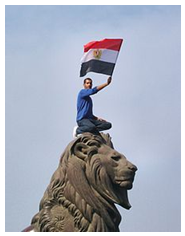
A protester holds an Egyptian flag during the protests that started on 25 January 2011 in Egypt
Following the self-immolation of Mohamed Bouazizi in Tunisia on 17 December, a man set himself ablaze on 17 January in front of the Tunisian parliament; about five more attempts of self-immolation followed.
National Police Day protests:
Opposition groups planned a day of revolt for 25 January, coinciding with the National Police Day. The purpose was to protest against abuses by the police in front of the Ministry of Interior. These demands expanded to include the resignation of the Minister of Interior, an end to State corruption, the end of Egyptian emergency law, and term limits for the president.
Many political movements, opposition parties, and public figures supported the day of revolt, including Youth for Justice and Freedom, Coalition of the Youth of the Revolution, the Popular Democratic Movement for Change and the National Association for Change. The 6 April Youth Movement was a major supporter of the protest and distributed 20,000 leaflets saying “I will protest on 25 January to get my rights”. The Ghad El-Thawra Party, Karama, Wafd and Democratic Front supported the protests. The Muslim Brotherhood, Egypt’s largest opposition group,[105] confirmed on 23 January that it would participate. Public figures including novelist Alaa Al Aswany, writer Belal Fadl, and actors Amr Waked and Khaled Aboul Naga announced they would participate. However, the leftist National Progressive Unionist Party (the Tagammu) stated it would not participate. The Coptic Church urged Christians not to participate in the protests.
Protests:
Under Hosni Mubarak’s rule
Main article: Timeline of the 2011 Egyptian revolution under Hosni Mubarak’s rule
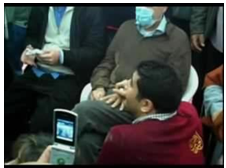
Al Jazeera footage of Egyptian protests
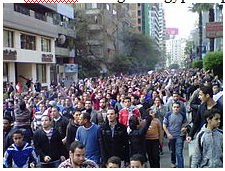
The “Day of Revolt” on 25 January

Hundreds of thousands of people protest in Tahrir Square on 4 February 2011

Hundreds of thousands of people protest in Tahrir Square on 8 February 2011

Hundreds of thousands of people protest in Tahrir Square on 9 February 2011

Hundreds of thousands of people celebrate in Tahrir Square when Hosni Mubarak’s resignation is announced on 11 February 2011
25 January 2011: The “Day of Revolt”: Protests erupted throughout Egypt, with tens of thousands of protesters gathered in Cairo and thousands more in cities throughout Egypt. The protests targeted President Hosni Mubarak’s government, and mostly adhered to non-violence. There were some reports of civilian and police casualties.
26 January 2011: “Shutting down The Internet and Mobile Services”: After several Facebook groups were created and tweets (from Twitter) called for mass demonstrations, the Egyptian government shut down internet access for most of the country.[113] This was done to cripple one of the protesters’ main organizational tools and to impede the flow of news and people.
28 January 2011: The “Friday of Anger” protests began. Hundreds of thousands demonstrated in Cairo and other Egyptian cities after Friday prayers. Opposition leader Mohamed ElBaradei arrived in Cairo. There were reports of looting. Prisons were opened and burned down, allegedly on orders from then-Minister of the Interior Habib El Adly. Prison inmates escaped en masse, in what was believed to be an attempt to terrorise protesters. Police forces were withdrawn from the streets, and the military was deployed. International fears of violence grew, but no major casualties were reported. President Hosni Mubarak made his first address to the nation and pledged to form a new government. Later that night clashes broke out in Tahrir Square between revolutionaries and pro-Mubarak demonstrators, leading to the injury of several and the death of some.
29 January 2011: The military presence in Cairo increased. A curfew was declared, but was widely ignored as the flow of defiant protesters to Tahrir Square continued throughout the night. The military reportedly refused to follow orders to fire live ammunition, and exercised restraint overall. There were no reports of major casualties.
1 February 2011: Mubarak made another televised address and offered several concessions. He pledged to not run for another term in the elections planned for September, and pledged political reforms. He stated he would stay in office to oversee a peaceful transition. Small but violent clashes began that night between pro-Mubarak and anti-Mubarak groups.
2 February 2011: “Battle of the Camel”. Violence escalated as waves of Mubarak supporters met anti-government protesters, and some Mubarak supporters rode on camels and horses into Tahrir Square, reportedly wielding swords and sticks. President Mubarak reiterated his refusal to step down in interviews with several news agencies. Incidents of violence toward journalists and reporters escalated amid speculation that the violence was being encouraged by Mubarak as a way to bring the protests to an end.
6 February 2011: A multifaith Sunday Mass is held with Egyptian Christians and Egyptian Muslims in Tahrir Square. Negotiations involving Egyptian Vice President Omar Suleiman and representatives of the opposition commenced amid continuing protests throughout the nation. The Egyptian army assumed greater security responsibilities, maintaining order and guarding The Egyptian Museum of Antiquity. Suleiman offered reforms, while others of Mubarak’s regime accused foreign nations, including the US, of interfering in Egypt’s affairs.
10 February 2011: Mubarak formally addressed Egypt amid speculation of a military coup, but rather than resigning (as was widely expected), he simply stated he would delegate some of his powers to Vice President Suleiman, while continuing as Egypt’s head of state. Reactions to Mubarak’s statement were marked by anger, frustration and disappointment, and throughout various cities there was an escalation of the number and intensity of demonstrations.
11 February 2011: The “Friday of Departure”: Massive protests continued in many cities as Egyptians refused the concessions announced by Mubarak. Finally, at 6:00 pm local time, Suleiman announced Mubarak’s resignation, entrusting the Supreme Council of Egyptian Armed Forces with the leadership of the country. Nationwide celebrations immediately followed.
Under Supreme Council of the Armed Forces:
See also: Timeline of the 2011 Egyptian revolution under Supreme Council of the Armed Forces

Hundreds of thousands of people protesting in Tahrir Square on 1 April 2011

Hundreds of thousands of people protesting in Tahrir Square on 8 April 2011

Tens of thousands of people protesting in Tahrir Square on 27 May 2011
13 February 2011: The Supreme Council dissolved Egypt’s parliament and suspended the Constitution in response to demands by demonstrators. The council declared that it would hold power for six months, or until elections could be held. Calls were made for the council to provide more details and specific timetables and deadlines. Major protests subsided but did not end. In a gesture to a new beginning, protesters cleaned up and renovated Tahrir Square, the epicenter of the demonstrations, although many pledged they would continue protests until all the demands had been met.
17 February 2011: The army stated it would not field a candidate in the upcoming presidential elections.[114] Four important figures of the former regime were detained on that day: former interior minister Habib el-Adly, former minister of housing Ahmed Maghrabi former tourism minister Zuheir Garana, and steel tycoon Ahmed Ezz.[115]
2 March 2011: The constitutional referendum was tentatively scheduled for 19 March 2011.[116]
3 March 2011: A day before large protests against him were planned, Ahmed Shafik stepped down as Prime Minister and was replaced by Essam Sharaf.[117]
5 March 2011: Several State Security Intelligence (SSI) buildings were raided across Egypt by protesters, including the headquarters for Alexandria Governorate and the main national headquarters in Nasr City, Cairo. Protesters stated they raided the buildings to secure documents they believed to show various crimes committed by the SSI against the people of Egypt during Mubarak’s rule.[118][119]
6 March 2011: From the Nasr City headquarters, protesters acquired evidence of mass surveillance and vote rigging, and noted rooms full of videotapes, piles of shredded and burned documents, and cells where activists recounted their experiences of detention and torture.[120]
19 March 2011: The constitutional referendum was held and passed by 77.27%.[121]
22 March 2011: Parts of the Interior Ministry building catch fire during police demonstrations outside.[122]
23 March 2011: The Egyptian Cabinet orders a law criminalising protests and strikes that hampers work at private or public establishments. Under the new law, anyone organising or calling for such protests will be sentenced to jail and/or a fine of LE500,000 (~100,000 USD).[123]
1 April 2011: The “Save the Revolution” day: Approximately four thousand demonstrators filled Tahrir Square for the largest protest in weeks, demanding that the ruling military council move faster to dismantle lingering aspects of the old regime.[124] Protestors demanded trial for Hosni Mubarak, Gamal Mubarak, Ahmad Fathi Sorour, Safwat El-Sherif and Zakaria Azmi as well.
8 April 2011: The “Friday of Cleaning”: Hundreds of thousands of demonstrators again filled Tahrir Square, criticizing the ruling Supreme Council of the Armed Forces for not following through on revolutionary demands. They demanded the resignation of remaining regime figures and the removal of Egypt’s public prosecutor due to the slow pace of investigations of corrupt former officials.[125]
27 May 2011: The “Second Friday of Anger” (a.k.a “Second Revolution of Anger” or “The Second Revolution”): Tens of thousands of demonstrators filled Tahrir Square in Egypt’s capital Cairo, besides[citation needed] perhaps demonstrators in each of Alexandria, Suez, Ismailia, Gharbeya and other areas; in the largest demonstrations since ousting Mubarak’s Regime. Protestors demanded No Military Trials for Civilians, the Egyptian Constitution to be made before the Parliament Elections and for all the old regime gang and those who killed protestors in January and February to be put on fair Trial.
1 July 2011: The “Friday of Retribution”; Hundreds of thousands of protesters gathered in Suez, Alexandria and Tahrir Square in Cairo, to voice frustration with the ruling Supreme Council of the Armed Forces for what they called the slow pace of change five months after the revolution, some also feared that the military is to rule Egypt indefinitely.[127]
8 July 2011: The “Friday of Determination”; Hundreds of thousands of protesters gathered in Suez, Alexandria and Tahrir Square in Cairo. They demanded immediate reforms and swifter prosecution of former officials from the ousted government.[128]
15 July 2011“‘: Hundreds of thousands continue to protest in Tahrir Square.
23 July 2011: Thousands of protesters try to march to the Defense Ministry. They are met with thugs that have sticks, stones, cocktails and other things. The protests are set off by a speech commemorating the 1952 coup led by Mohammed Tantawi.
1 August 2011: Egyptian soldiers clash with protesters, tearing down tents. Over 66 people were arrested. Most Egyptians supported the military’s action.
6 August 2011 Hundreds of protesters gathered and prayed in Tahrir Square. After they were done, they were attacked by the military.
9 September 2011: The “2011 Israeli embassy attack”; The“Friday of Correcting the Path”; Tens of thousands of people protested Suez, Alexandria, Cairo, and other cites. Islamist protesters were absent.
9 October 2011: The “Maspero demonstrations”; Late into the evening of 9 October, during a protest that was held in Maspiro,[129] peaceful Egyptian protesters, calling for the dissolution the Supreme Council of the Armed Forces, the resignation of its chairman, Field Marshal Mohamed Tantawi, and the dismissal of the governor of Aswan province, were attacked by military police. At least 25 people[130] were killed and more than 200 wounded.
19 November 2011: Clashes first erupt in Tahrir Square as demonstrators reoccupy the location in central Cairo. Central Security Forces deploy tear gas in an attempt to control the situation.[131]
20 November 2011: Police forces attempt to forcibly clear the square, but protesters soon return in more than twice their original numbers. Fierce fighting breaks out and continues through the night, with the police again using tear gas, beating and shooting demonstrators.[131]
21 November 2011: Demonstrators return to the square, with Coptic Christians standing guard as Muslims protesting the regime pause for prayers. The Health Ministry says at least 23 have died and over 1,500 have been wounded since 19 November.[131] Solidarity protests are held in Alexandria, Suez, and at least five other major Egyptian cities.[132] Dissident journalist Hossam el-Hamalawy tells Al Jazeera that Egyptians will launch a general strike because they have “had enough” of the SCAF.[133]
Cities and regions : Mass civil disobedience:

Protesters in Alexandria

Protesters remove portraits of Ex-president Mubarak in Sohag City in upper Egypt
Cairo
Cairo has been at the epicentre of much of the crisis. The largest protests were held in downtown Tahrir Square, which was considered the “protest movement’s beating heart and most effective symbol.”[134] On the first three days of the protests, there were clashes between the central security police and protesters and on 28 January, police forces withdrew from all of Cairo. Citizens formed neighbourhood watch groups to keep the order as widespread looting was reported. Traffic police were reintroduced to Cairo on the morning of 31 January.[135] An estimated 2 million people protested at Tahrir square.
Deaths:

A memorial in Tahrir Square made by the demonstrators in honour of those who died during the protests, regarded as shuhada’ شهداء – “martyrs” – in Egyptian parlance. The captions in the pictures attribute most of the deaths to police violence.

Sally Zahran, a female protester who was a victim during demonstrations. NASA announced plans to write her name on a rocket, as part of a tradition of the American space organization’s Jet Propulsion Laboratory to engrave the names of notable people on spacecraft at the request of NASA staff members or US citizens. “This is the least we could do for Egypt’s youth and the revolutionaries. This step represents the transfer of the dreams of Egyptian young people from a small stretch of earth to the enormous expanse of space” said NASA researcher Essam Mohamed Haji.
Leading up to the protests, six cases of self-immolation were reported, including a man arrested while trying to set himself on fire in downtown Cairo. These cases were inspired by, and began exactly one month after, the acts of self-immolation in Tunisia triggering the 2010–2011 Tunisian uprising. The self-immolated included Abdou Abdel-Moneim Jaafar,[150] Mohammed Farouk Hassan,[151] Mohammed Ashour Sorour, and Ahmed Hashim al-Sayyed who later died from his injuries.


As of 30 January, Al Jazeera reported as many as 150 deaths in the protests.[169] The Sun reported that the dead could include at least 10 policemen, 3 of whom were killed in Rafah by “an enraged mob”.[170]
By 29 January, 2,000 people were known to be injured.[171] The same day, an employee of the Azerbaijani embassy in Egypt was killed while returning home from work in Cairo;[172] the next day Azerbaijan sent a plane to evacuate citizens[173] and opened a criminal investigation into the death.[174]
Funerals for the dead on the “Friday of Anger” were held on 30 January. Hundreds of mourners gathered for the funerals calling for Mubarak’s removal.[175] By 1 February, the protests had left at least 125 people dead,[176] although Human Rights Watch said that UN High Commissioner for Human Rights Navi Pillay claimed that as many as 300 people may have died in the unrest. This unconfirmed tally included 80 Human Rights Watch-verified deaths at two Cairo hospitals, 36 in Alexandria, and 13 in the port city of Suez, among others;[156][177][178] over 3,000 people were also reported as injured.[156][177][178]
An Egyptian Governmental Fact-Finding mission Known as ” Fact-Finding National commission About 25 Jan Revolution” announced on 19 April that at least 846 Egyptians died in the nearly three week long popular uprising.[166][167][168]
International reactions:
International reactions have varied with most Western states saying peaceful protests should continue but also expressing concern for the stability of the country and the region. The European Union’s Foreign Affairs Chief issued a statement saying “I also reiterate my call upon the Egyptian authorities to urgently establish a constructive and peaceful way to respond to the legitimate aspirations of Egyptian citizens for democratic and socioeconomic reforms.”[179] The United States, Britain, France, Germany and others issued similar statements calling for reforms and an end to violence against peaceful protesters. Many states in the region expressed concern and supported Mubarak, in particular Saudi Arabia, which issued a statement saying it “strongly condemned” the protests,[180] while others, like Tunisia and Iran, supported the protests. Israel was most cautious for a change, with Israeli Prime Minister Benjamin Netanyahu asking his government ministers to maintain silence, and urging Israel’s US and European allies to curb their criticism of President Mubarak;[181][182] however, an Arab-Israeli parliamentarian supported the protests. There were also numerous solidarity protests for the anti-government protesters around the world.
NGOs also expressed concern about the protests and the ensuing heavy-handed state response. Amnesty International described attempts to discourage protests as “unacceptable”.[183] Many countries also issued travel warnings or began evacuating their citizens, including the US, Israel, Great Britain, and Japan. Even multinational corporations began evacuating their expatriate workers. Many university students were also evacuated.
Post-ousting:
Many nations, leaders, and organizations hailed the end of the Mubarak regime. There were celebrations in Tunisia, and Lebanon. World leaders including Angela Merkel, David Cameron joined in praising the Revolution. United States President Barack Obama praised the achievement of the Egyptian people and encouraged other activists by saying “let’s look at Egypt’s example”[186] Amid the growing concerns for the country, on 21 February, David Cameron, Prime Minister of the United Kingdom, became the first world leader to visit Egypt since Mubarak was ousted as the president 10 days previously. A news blackout was lifted as the prime minister landed in Cairo for a brief five-hour stopover hastily added at the start of a planned tour of the Middle East. On 15 March United States Secretary of State Hillary Clinton visited Egypt, she was the highest ranking US official to visit Egypt after the handover of power from Mubarak to the military. Clinton urged the military leaders to begin the process of a democratic transition and offer support to those who had been protesting, as well as reaffirming ties between the two nations.
Results:

“Nero burned Rome; Mubarak is burning Egypt”
On 29 January, Mubarak indicated he would be changing the government because despite a “point of no return” being crossed, national stability and law and order must prevail, that he had requested the government, formed only months ago, to step down, and that a new government would be formed. He then appointed Omar Suleiman, head of Egyptian Intelligence, as vice president and Ahmed Shafik as prime minister. On 1 February, he spoke again saying he would stay in office until the next election in September 2011 and then leave without standing as a candidate. He also promised to make political reforms. He made no offer to step down.
On 31 January, Mubarak swore in his new cabinet in the hope that the unrest would fade. The protesters did not leave and continued to demonstrate in Cairo’s Tahrir Square to demand the downfall of Mubarak. The vice-president and the prime minister were already appointed.[192] He told the new government to preserve subsidies, control inflation and provide more jobs.[193]
On 1 February, Mubarak said he never intended to run for reelection in the upcoming September presidential election, though his candidacy had previously been announced by high-ranking members of his National Democratic Party.
In his speech, he asked parliament for reforms:
According to my constitutional powers, I call on parliament in both its houses to discuss amending article 76 and 77 of the constitution concerning the conditions on running for presidency of the republic and it sets specific a period for the presidential term. In order for the current parliament in both houses to be able to discuss these constitutional amendments and the legislative amendments linked to it for laws that complement the constitution and to ensure the participation of all the political forces in these discussions, I demand parliament to adhere to the word of the judiciary and its verdicts concerning the latest cases which have been legally challenged.
—Hosni Mubarak, 1 February 2011
Various opposition groups, including the Muslim Brotherhood (MB), reiterated demands for Mubarak’s resignation. The MB also said, after protests turned violent, that it was time for the military to intervene.[197] Mohammed ElBaradei, who said he was ready to lead a transitional government,[198] was also the consensus candidate by a unified opposition including: the 6 April Youth Movement, We Are All Khaled Said Movement, National Association for Change, 25 January Movement, Kefaya and the Muslim Brotherhood. ElBaradei formed a “steering committee”.[200] On 5 February, a “national dialogue” was started between the government and opposition groups to work out a transitional period before democratic elections.
Many of Al-Azhar Imams joined the protesters on 30 January all over the country. Christian leaders asked their congregations to stay away from protests, though a number of young Christian activists joined the protests led by Wafd Party member Raymond Lakah.
The Muslim Brotherhood joined the revolution on 30 January, calling on all opposition groups to unite against Mubarak, and for the military to intervene. They joined other opposition groups in electing Mohammed el Baradei to lead a National Salvation Government in the interim period.
The Egyptian state cracked down on the media, and shut down internet access, a primary means of communication for the opposition. Journalists were also harassed by the regime’s supporters, eliciting condemnation from the Committee to Protect Journalists, European countries and the United States.
Reform process:
The protests initiated a process of social and political reform by articulating a series of demands. Reform began with President Mubarak’s announcements that concessions would be made towards reform and was highlighted by his resignation 18 days after the protests started. The list of demands for broader changes in Egyptian society and governance, articulated by protesters and activists, includes the following:

A sign with the protesters’ omnibus demands

Shredded documents found inside State Security Investigations Service
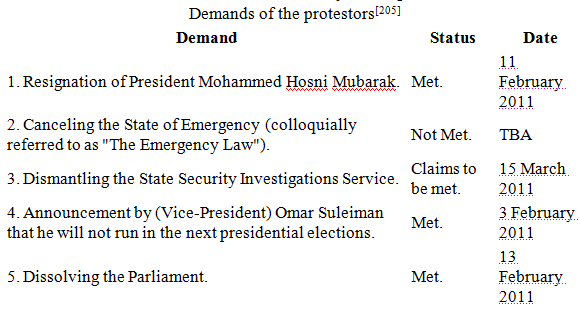
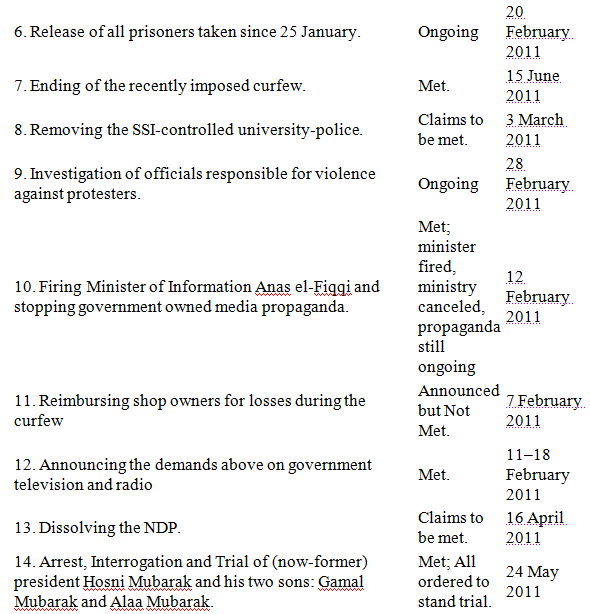

On 17 February, an Egyptian prosecutor ordered the detention of three ex-ministers, former Interior Minister Habib el-Adli, former Tourism Minister Zuhair Garana and former Housing Minister Ahmed el-Maghrabi, and a prominent businessman, steel magnate Ahmed Ezz, pending trial on suspicion of wasting public funds. The public prosecutor also froze the accounts of Adli and his family members on accusations that over 4 million Egyptian pounds ($680,000) were transferred to his personal account by a head of a contractor company, while calling on the Foreign Minister to contact European countries and ask them to freeze the accounts of the defendants.[210]
Meanwhile, the United States announced on the same day that it was giving Egypt $150 million in crucial economic assistance to help it transition towards democracy following the overthrow of long time president Mubarak. US Secretary of State Hillary Clinton said that William Burns, the Under-secretary of State for political affairs, and David Lipton, a senior White House adviser on international economics, would travel to Egypt the following week.[210]
On 19 February, a moderate Islamic party, named Al-Wasat Al-Jadid, or the New Center Party, which was outlawed for 15 years was granted official recognition by an Egyptian court. The party was founded in 1996 by activists who split off from the Muslim Brotherhood and sought to create a tolerant Islamic movement with liberal tendencies, but its attempts to register as an official party were rejected four times since then. On the same day, Prime Minister Ahmed Shafiq said 222 political prisoners would be released. He said only a few were detained during the popular uprising and put the number of remaining political prisoners at 487, but did not say when they would be released.[211]
On 20 February, Dr. Yehia El Gamal a well known activist and law professor, announced (on TV channels) accepting a Vice Prime Minister position within the new government that will be announced on 21–22 February. He also announced the removal of many of the previous government members to alleviate the situation.
On 21 February, the Muslim Brotherhood announced it would form a political party for the upcoming parliamentary election, called the Freedom and Justice Party, which was to be led by Dr. Saad Ketatni.[212][213][214] Its spokesperson noted that “when we talk about the slogans of the revolution – freedom, social justice, equality – all of these are in the Sharia (Islamic law).”
Court trials of state officials accused of corruption:
The ousting of Mubarak was followed by a series of arrests of, and / or imposed travel bans on high profile figures on charges of causing the death of 300–500 demonstrators, and the injury of 5,000 more, as well as charges of embezzlement, profiteering, money laundry, and abuse of human rights. Among these figures are Mubarak himself, his wife Suzanne Mubarak, his son Gamal, his son Alaa, the former Interior Minister Habib el-Adly, the former Housing Minister Ahmed El-Maghrabi, the former Tourism Minister Zoheir Garana and the former Secretary of the National Democratic Party for Organisational Affairs Ahmed Ezz. Mubarak’s ousting was also followed by widespread allegations of corruption against numerous other government officials and senior politicians On 28 February 2011, Egypt’s top prosecutor ordered an asset freeze for Mubarak and his family. This was followed by arrest warrants, travel bans and judicial orders to freeze the assets of other known public figures, including the former Speaker of the Egyptian Parliament, Fathi Sorour, and the former Speaker of the Higher Legislative Body (Shura Council), Safwat El Sherif. Arrest warrants were also issued against some public figures who left the country with the outbreak of the revolution. These warrants were issued on allegations of financial misappropriations, rather than human rights abuses. Among these public figures are Rachid Mohamed Rachid, the former Minister of Trade and Industry and Hussein Salem, a business tycoon. Salem is believed to have left for Dubai.
Trials of the accused officials started on 5 March 2011 when the former Interior Minster of Egypt, Habib el-Adli, appeared before the Giza Criminal Court in Cairo.The trials of el-Adli and other public figures are expected to run a lengthy course.
In March 2011, following the revolution, Abbud al-Zumar, one of Egypt’s most famous political prisoners, was freed after 30 years. He was founder and first emir of the Egyptian Islamic Jihad, and implicated in the assassination of President Anwar Sadat on 6 October 1981.
On 24 May, former Egyptian President Mubarak was ordered to stand trial on charges of premeditated murder of peaceful protestors during the 2011 Egyptian revolution and, if convicted, could face the death penalty. The full list of charges released by the public prosecutor was “intentional murder, attempted killing of some demonstrators…misuse of influence and deliberately wasting public funds and unlawfully making private financial gains and profits.
Analysis:
Regional instability
The Egyptian Revolution, along with the events in Tunisia, have sparked a wave of major uprisings. Demonstrations and protests have spread across the Middle East and North Africa. To date Algeria, Bahrain, Iran, Jordan, Libya, Morocco,Yemen, and Syria have all witnessed major protests. In addition, minor incidents have occurred in Iraq, Kuwait, Mauritania, Oman, Saudi Arabia, Somalia, and Sudan.
Religion and politics
Further information: Islam and democracy and Secularism in Egypt
See also: Muslim Brotherhood in Egypt, Gama’at Islamiya, and Egyptian Islamic Jihad
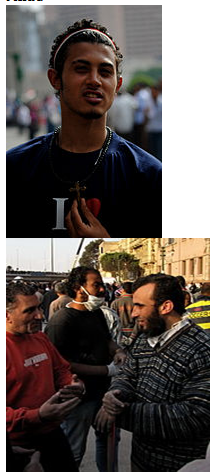
A Muslim wearing the cross in solidarity with Christian; and a Copt Christian (left) and a Salafi Muslim (right) debate in Tahrir Square on politics and the revolution
The protests in Egypt were not centred around religion-based politics, but nationalism and a broad-based social consciousness. Before the uprising, the most organised and prominent opposition movements throughout the Arab world usually came from Islamist organisations that relied on a conviction of their faith, where members were motivated and ready to sacrifice. However, secular forces emerged from the revolution touting principles that religious groups shared with them: freedom, social justice, and dignity. Islamist organisations also emerged with greater freedom to operate. Although the cooperative, inter-faith revolution itself was no guarantee that partisan politics would not re-emerge in its wake, its success nonetheless represented a change from the intellectual stagnation created by decades of repression which simply pitted modernity and Islam against one another as conflicting and incompatible. Islamists and secularists both have been faced with new opportunities for dialogue and discourse, on matters such as the role of Islam and Sharia in society and freedom of speech, as well as the impact of secularism on a predominantly Muslim population.
Women’s role
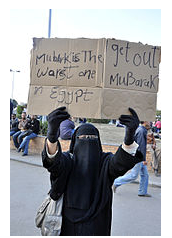
A female protester wearing a niqāb
Egyptian women were active throughout the revolution. Some took part in the protests themselves, were present in news clips and on Facebook forums, and were part of the leadership during the Egyptian revolution. In Tahrir Square, female protesters, some with their children, worked to support the protests. The diversity of the protesters in Tahrir Square was visible in the women who participated; many wore head scarves and other signs of religious conservatism, while others revelled in the freedom to kiss a friend or smoke a cigarette in public. Egyptian women also organised protests, and reported on the events; female bloggers such as Leil Zahra Mortada risked abuse or imprisonment by keeping the world informed of the daily scene in Tahrir Square and elsewhere. Among those who died was Sally Zahran, who was beaten to death during one of the demonstrations. NASA reportedly plans to name one of its Mars exploration spacecraft in Zahran’s honour.
The wide participation and the significant contributions by Egyptian women to the protests have been attributed to the fact that many, especially younger women, are better educated than previous generations, representing more than half of Egyptian university students. This has been an empowering factor for women, who have become more present and active publicly in recent years. The advent of social media has also helped provide tools for women to become protest leaders.
The military’s role
Further information: Egyptian Armed Forces

From left to right: One of the 2 army vehicles that were burned during the army attacks on 9 April 2011 and one of the protestors holding some of the army bullets, standing in front of a burning army vehicle that was burned during the army attack on 9 April 2011 in Tahrir Square, at least 2 protestors were killed by the army and tens wounded.
The Egyptian Armed Forces enjoy a better reputation with the public than the police does, the former perceived as a professional body protecting the country, the latter accused of systemic corruption and illegitimate violence. All four Egyptian presidents since the 1950s have come from the military into power. Key Egyptian military personnel include the Defense Minister Mohamed Hussein Tantawi and General Sami Hafez Enan, Chief of Staff of the Armed Forces. The Egyptian military totals around 468,500 well-armed active personnel, plus a reserve of 479,000.
As Head of Egypt’s Armed Forces, Tantawi has been described as “aged and change-resistant” and is attached to the old regime. He has used his position as Defense Minister to oppose reforms, economic and political, which he saw as weakening central government authority. Other key figures, Sami Enan chief among them, are younger and have closer connections to both the US and groups such as the Muslim Brotherhood. An important aspect of the relationship between the Egyptian and American military establishments is the 1.3 billion dollars in military aid provided to Egypt annually, which in turn pays for American-made military equipment, and allows Egyptian officers to receive training in the US. Guaranteed this aid package, the governing military council is for the most reform-resistant.One analyst however, while conceding that the military is change-resistant, states it has no option but to facilitate the process of democratisation. Furthermore, the military will have to keep its role in politics limited to continue good relations with the West, and must not restrict the participation of political Islam if there is to be a genuine democracy.
Foreign relations:
Foreign governments in the West including the US have regarded Mubarak as an important ally and supporter in the Israeli-Palestinian peace negotiations. After wars with Israel in 1948, ’56, ’67 and ’73, Egypt signed a peace treaty in 1979, provoking controversy in the Arab world. As provisioned in the 1978 Camp David Accords, which led to the peace treaty, both Israel and Egypt receive billions of dollars in aid annually from the United States, with Egypt receiving over US$1.3 billion of military aid each year in addition to economic and development assistance. According to Juan Cole, many Egyptian youth feel ignored by Mubarak on the grounds that he is not looking out for their best interests and that he rather serves the interests of the West. The cooperation of the Egyptian regime in enforcing the blockade of the Gaza Strip was also deeply unpopular among the general Egyptian public.
Online activism and the role of social media

Coverage by the news network Al Jazeera English provided information about the revolution outside Egypt.
The April 6 Youth Movement is an Egyptian Facebook group started in Spring 2008 to support the workers in El-Mahalla El-Kubra, an industrial town, who were planning to strike on April 6. Activists called on participants to wear black and stay home on the day of the strike. Bloggers and citizen journalists used Facebook, Twitter, Flickr, blogs and other new media tools to report on the strike, alert their networks about police activity, organize legal protection and draw attention to their efforts. The New York Times has identified the movement as the political Facebook group in Egypt with the most dynamic debates. As of January 2009[update], it had 70,000 predominantly young and educated members, most of whom had not been politically active before; their core concerns include free speech, nepotism in government and the country’s stagnant economy. Their discussion forum on Facebook features intense and heated discussions, and is constantly updated with new postings.
the founders of the movement
- Ahmed Maher was a prominent participant in the anti-Mubarak demonstrations in Egypt in 2011.
- Asmaa Mahfouz posted a video blog that went viral. She urged the Egyptian people to join her in a protest on January 25, in Tahrir Square to bring down Mubarak’s regime and urged people not to be afraid.
- Waleed Rashed born November 15, 1983 in El Sharkia, Egypt), is one of the co-founders of the April 6 Youth Movement and a prominent participant in the anti-Mubarak demonstrations in Egypt in 2011.
We Are All Khaled Saeed is a Facebook group which formed in the aftermath of Saeed’s beating and death. The group attracted hundreds of thousands of members worldwide and played a prominent role in spreading and bringing attention to the growing discontent. As the protests began, Google executive Wael Ghonim revealed that he was the person behind the account. Later after the revolution, in an TV interview in the presence of member of the ruling military council, it was revealed that AbdulRahman Mansour, a young underground activist and media expert shared the account with Wael Ghonim. Another potent viral online contribution was made by Asmaa Mahfouz, a female activist who posted a video in which she challenged people to publicly protest.Previously, Facebook had suspended the group because some of its administrators were using pseudonyms, a violation of the company’s ‘Terms of Service.’
The usage of social media has been extensive. As one Egyptian activist succinctly tweeted during the protests there, “We use Facebook to schedule the protests, Twitter to coordinate, and YouTube to tell the world.” Internet censorship has also been extensive, and in some cases comprehensive to the extent of taking entire nation-states practically off-line.
It is readily believed that a handful of people through Facebook, Twitter, and blogging sparked this uprising. One of which is Wael Ghonim. Many believe Ghonim was the first contributor to spark the Egypt revolution when he created a Facebook page dedicated to Khaled Saeed entitled We Are All Khaled Saeed . Saeed, an Egyptian business man was beaten to death by police in June 2010. It is believed that this was in retaliation to a video he posted showing Egyptian police sharing the spoils of a drug bust. The Facebook page blew up to over 400,000 followers, creating an online arena where protestors and those discontent with the government could gather, vent, and organise. The page called for protests on 25 January, Known as the day of wrath. Hundreds of thousands of protestors flooded the streets to show their discontent with the murder and the corruption within their country. Ghonim was jailed the 28th and released 12 days later. Ghonim has also gained quite a large following through his Twitter account where he has been creating a narrative of the events happening day to day in Egypt. Ghonim is the Middle East and North African marketing manager at Google. He is currently on leave.
Another major contributor is Egyptian activist and member of the 6 April movement
Though these two are credited with being the first social media faces of this revolution, since the 25th people have posted videos, tweeted, and wrote Facebook comments to keep the world abreast of the turmoil in Egypt. Including videos posted of a badly beaten Khaled Said, disproving the first claims by the police that he had choked to death. Ali documents the various ways in which social media was used by Egyptian activists, some of the most prominent Egyptian celebrities, and as well by major political figures abroad to invigorate the protests.
Sharif Abdel Kouddous, a journalist with Democracy Now! had provided live coverage and tweets from Tahrir Square during the protests and has also been credited with using new media to raise awareness regarding the protests.
The role of social media in the Egyptian uprising has since been widely written and debated about, including in the first edition of the Dubai Debates on the question “Mark Zuckerberg – the new hero of the Arab people?” Many have argued, based in part on the Egyptian revolution, that social media may be an effective tool in developing nations more generally.
After-Revolution Freedom of Establishing Political Parties:
Freedom was given to establish political parties only by “notifying” concerned authorities, resulting in establishing several political parties named after or in relation to the 25 January revolution.

